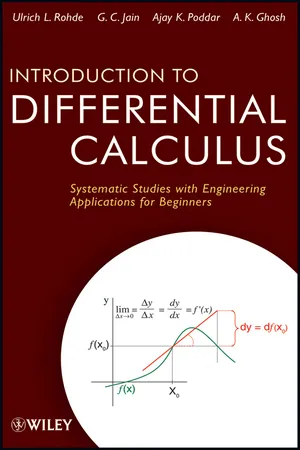Mathematics
Instantaneous Rate of Change
The instantaneous rate of change is the rate at which a quantity is changing at a specific point in time. In calculus, it is represented by the derivative of a function and gives the slope of the tangent line to the graph of the function at a particular point. It provides a precise measure of how a function is changing at a single moment.
Written by Perlego with AI-assistance
Related key terms
5 Key excerpts on "Instantaneous Rate of Change"
- eBook - ePub
- William L. Schaaf(Author)
- 2014(Publication Date)
- Dover Publications(Publisher)
t also increases at a constant, though smaller rate; the curve is again a straight line, but not as steep. Thus the rate of change is shown by the slope, or steepness, of the curve, not by its height at any point.The important concept to be grasped here is that the rate of change is the amount of change in the function (or dependent variable) per unit change in the independent variable. Similarly, if the rate of change of a function is constant, the curve of the function must be a straight line, since it rises (increase in ordinate) by the same amount in each horizontal unit (increase in abscissa).1—9. Graphic Determination of Average and Instantaneous Rates. It so happens, however, that most quantities change at a varying rate. For example, a train may cover a total distance of 150 miles in 3 hours, or at an average rate of 50 miles per hour. Yet it may well have been moving at rates greater or less than 50 miles per hour at any particular instant during those three hours, or even for the duration of some interval within that period of three hours.It is therefore necessary to distinguish between an average rate of change during an interval, on the one hand, and an instantaneous rate at some particular instant, on the other hand.These rate of change concepts may be illustrated by the following examples. In our first illustration, the curve shows the variation of the amount of a chemical dissolved as the temperature changes. Thus, when the temperature increases from 30° to 40°, the amount dissolved increases from 20 gm. to 28 gm.; or, a total increase of 8 gm. in an interval of 10°. Thus the average rate of change equals 8 ÷ 10, or .8 gram per degree, during this 10-degree interval. Had we selected a larger or a smaller interval, or an equal interval elsewhere along the curve, the average rate of change would, of course, have been different. But now consider this question: how fast was the amount dissolved increasing at the instant when the temperature was 30°? To find the answer, we determine how steep the curve is at the point where T = 30°; that is, the tangent to the curve at this point measures the steepness of the curve at that point, and so indicates the rate at which it would continue to increase if the rate of change were to become constant at that instant Naturally, drawing a tangent to a curve at a given point “free-hand,” or by inspection, even with the aid of a ruler, is at best only an approximation. In this case, a tangent to the curve at T = 30°, when extended, meets the ordinate drawn through the abscissa T = 40° at the point where the amount is 23 gm. Hence, a uniform increase of 3 gm. in an interval of 10°, or a constant rate of change of .3 of a gram per degree, which is the same as the instantaneous rate at the particular instant T = - eBook - ePub
Introduction to Differential Calculus
Systematic Studies with Engineering Applications for Beginners
- Ulrich L. Rohde, G. C. Jain, Ajay K. Poddar, A. K. Ghosh(Authors)
- 2012(Publication Date)
- Wiley(Publisher)
acceleration .As another example, the pressure of the atmosphere varies with height above the surface of the Earth. Given the formula that relates pressure and height, we can calculate the rate of change of pressure compared to height at any given height and the rate of change of surface area of a cube, with respect to the length of its edge.26Remark: The original calculus problems of speed and acceleration did involve time and were concerned with rates at an instant of time. Our interest lies in computing the rate of change of the dependent variable y [= f (x )] with respect to the independent variable x at any value of x . All such rates are referred to as instantaneous rates , despite the fact that time may not be one of the variables involved.9.5.5 From the above discussion, we note the following:i. If y is a function of x denoted by y = h (x ), whose graph is a curve, then the slope of the curve at any point P (x , y ) on the curve, is given by the limit , provided this limit exists . We denote it by .ii. Consider a particle “P” moving in a straight line. Suppose the position of the particle at any instant “t ” is expressed by function y = g (t ), then the velocity of the particle at any instant t is given by the limit , provided this limit exists . We denote it by .iii. Let the velocity of a particle at any instant t be given by the function v = ϕ(t ), then the Instantaneous Rate of Change of velocity at any instant t , is given by the limit , provided this limit exists . We denote it by . It is called the instantaneous acceleration of the particle - eBook - ePub
How to be a Quantitative Ecologist
The 'A to R' of Green Mathematics and Statistics
- Jason Matthiopoulos(Author)
- 2011(Publication Date)
- Wiley(Publisher)
x ).To calculate the Instantaneous Rate of Change, consider a fixed point (x 1 , f (x 1 )) and a movable point (x , f (x )) on the graph of the function. The slope of the secant through these two points can be calculated from Equation (4.7 ). If x is allowed to approach x 1 (Figure 4.4 ), then f (x ) should also approach f (x 1 ).Figure 4.4 As the point B approaches the point A by travelling along the graph of f (x ), the slope of the secant gives the rate of change of the function over ever-smaller intervals.When the value of x becomes almost identical to x 1 , the secant is called the tangent to the function's graph at the point (x 1 , f (x 1 )) and the slope of the tangent is the slope of the graph of the function at that point; the Instantaneous Rate of Change of f (x ) at x 1 . Mathematically, this is written using the new notation of limits (examined more thoroughly in the following section),4.84.2: Visualising The Instantaneous Rate of ChangeThe following code will generate a plot similar to Figure 4.4 . You can look at different functions by changing the original specification (here, f (x ) = x 3 ). You can look at different points of the function's graph by changing the value of x (here, x = 3). You can look at different magnifications of the plot by modifying the values of Xmin and Xmax . If you tighten the plotting range (e.g. setting x<-3, Xmin<-2.9 and Xmax<-3.1 - eBook - ePub
Teaching Secondary School Mathematics
Research and practice for the 21st century
- Merrilyn Goos, Gloria Stillman, Sandra Herbert, Vince Geiger(Authors)
- 2020(Publication Date)
- Routledge(Publisher)
Chapter 8 , middle secondary students have difficulties with the concept of rate, so it is not surprising that students of calculus have difficulties with differentiation that have persisted over many years (Hashemi, Abu, Kashefi & Rahimi, 2014; Orton, 1983).Figure 12.6Drawing a tangent to the curve at the point (–3.5, 0.9)Figure 12.7Drawing secants approaching the tangent to the curve at the point (–3.5, 0.9)Figure 12.8Constant rate of change of height of a stack of plastic cups, per cupStudents need many early experiences with constant (e.g., stacking plastic cups, see Figure 12.8 ) and non-constant rates of changes (e.g., shortest-path problems, see Figures 12.9 and 12.10 ) and being asked to distinguish between these, using information from all three representations.The key question being asked is how does the rate at which the y values are changing compare with the rate at which the x values are changing? Distinguishing between change (i.e., Δx or Δy) and rate of change (i.e.,) causes problems for students. They have difficulty understanding the difference between a difference and a ratio of differences.Δ yΔ xIn the following exchange, for example, the students are trying to answer a question about the rate at which the total distance travelled by a runner is changing as the runner traverses a field via one of 18 equally spaced drink stations along one side of the field (see Figure 12.10 ). The runner must travel via only one drink station after entering through one gate and leaving via a second gate.Figure 12.9Varying rate of change of total distance run with station distanceFigure 12.10Path and distance travelled by runnerThomas: Does the total distance change at the same rate as you travel via station 1, or 2 or 3 or 4?Andrea: Yes.Thomas: - EK Ummer(Author)
- 2012(Publication Date)
- Routledge(Publisher)
x). Therefore, we have the equationIf we multiply the relative rate of change by 100, we obtain the percentage rate of change of f (x). Therefore, we have the equation3.3.15 Application ExamplesExample 1. Assume that the inverse demand function for a firm’s product is given by p = f (q) = 25/q, where p denotes the per unit price in dollars and q denotes the quantity of the good demanded. Find the rate of change of price with respect to quantity. How fast will the price change when q = 10?Solution. We can find the rate of change of price with respect to quantity by differentiating the function with respect to q. Therefore, applying the quotient rule yields dp/dq = {[q.d(25)/dq] − 25.d(q)/dq}/(q)2 = (0 − 25)/(q)2 = −25/(q)2 . This means that the rate of change of price with respect to quantity demanded is dp/dq = −25/(q)2 . This implies that when q = 10, dp/dq|q=10 = −25/(q)2 /102 = −25/100 = −0.25. This suggests that an increase of one unit of the good demanded when q = 10 reduces the price by 25 cents. Notice that, to have any economic sense out of this result, we have to interpret it oppositely.Example 2. Suppose that a company’s total revenue is given by the function R = f (q) = 50q − 0.2q2 , where R denotes the total revenue in dollars and q denotes the total quantity of the good sold by the company. Find the marginal revenue when q = 20. Also find the percentage rate of change of revenue with respect to the quantity of the good sold when q = 20 and interpret the result.Solution. Marginal revenue is obtained by differentiating the total revenue function with respect to the quantity of the good sold. Therefore, using the sum–difference rule and the power rule of differentiation jointly we obtain dR/dq
Learn about this page
Index pages curate the most relevant extracts from our library of academic textbooks. They’ve been created using an in-house natural language model (NLM), each adding context and meaning to key research topics.




